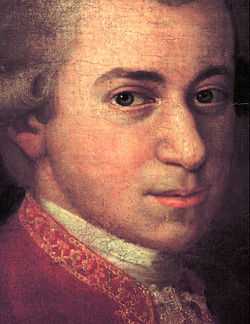Adagio and Fugue in C minor (Mozart)
The Adagio and Fugue in C minor, K. 546, is a composition by Wolfgang Amadeus Mozart for strings. Entered into Mozart’s work catalogue on 26th June, 1788 in Vienna and titled “A short Adagio; for a fugue which I had already written a long time ago for two Pianos". The fugue in question was the two piano fugue in C minor, K. 426, written in December of 1783.
Form
- The work is laid out into two parts:
- 1. Adagio
- 2. Fuga (Allegro)
The 52 bar adagio has a very ominous and foreboding tone; musicologist Robert D. Levin said: “Angular outbursts alternate with an unearthly hush; its suggestions of violence and mysticism make the ensuing geometry of the fugue seem a relief”. The adagio section is notated in 3/4 time, and the fugue is written as an Allegro alla breve.
Composition
The reasoning for the works composition remains a mystery, as there was no known commission for it. A possible theory is that it was composed on a suggestion by F. A. Hoffmeister, who originally published the work. 1788 was also a time of great contrapuntal composition for Mozart; it was near this time he would have composed a grand fugue in a similar key, C major, for the finale of his 40th symphony in G minor, K. 550. As such, perhaps fugal workings became foremost in Mozart's mind for a short period of time.
The fugue of 546 is now the only portion of the work that remains in its original autographed format, with the adagio being lost for centuries. The instrumentation of the autograph indicates the work to be played for “Violincelli” with “celli” being plural, and the bass section, marked for “Contra Bassi”, with “bassi” also being plural. The plurality notated in the instrumentation suggests the work was to be performed for a string orchestra, rather than string quartet. In modern times, the work is typically played for string quartet, though, a few recordings can be found using the interpreted orchestral version.
References
- Zaslaw, Neal. The Compleat Mozart: A Guide to the Musical Works of Wolfgang Amadeus Mozart. New York: Mozart Bicentennial at Lincoln Center :, 1990. 268, 269. Print.
- Eisen, Cliff. The Cambridge Mozart Encyclopedia. Cambridge [England: Cambridge UP, 2006. Print.
- Abert, Hermann, Stewart Spencer, and Cliff Eisen. W.A. Mozart. New Haven [Conn.: Yale UP, 2007. Print.
External links
- Adagio und Fuge in c: Score and critical report (German) in the Neue Mozart-Ausgabe
| ||||||||||||||||||||
